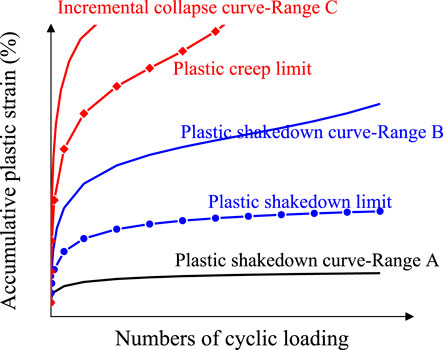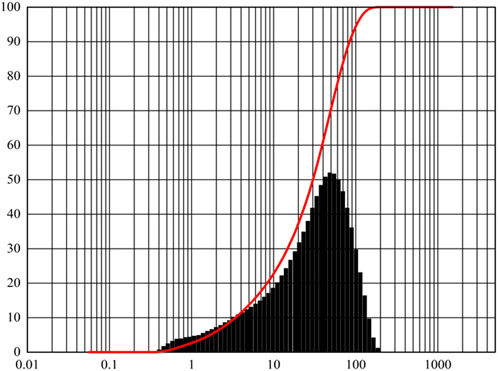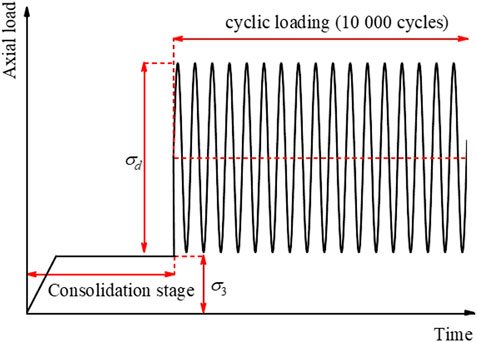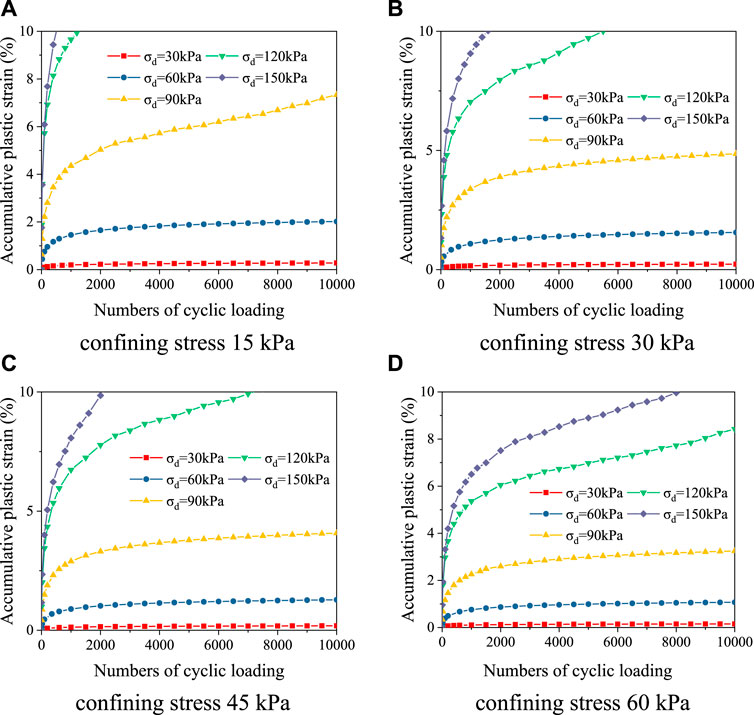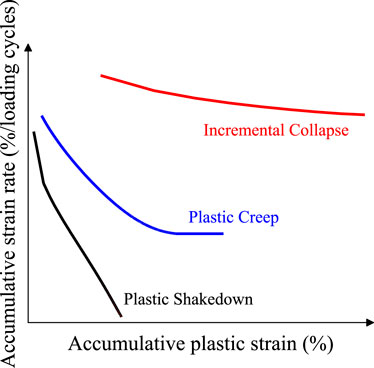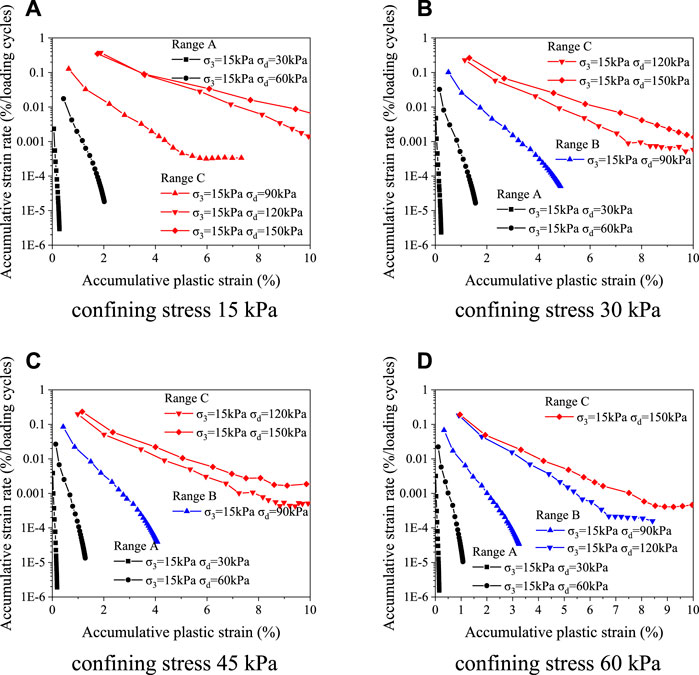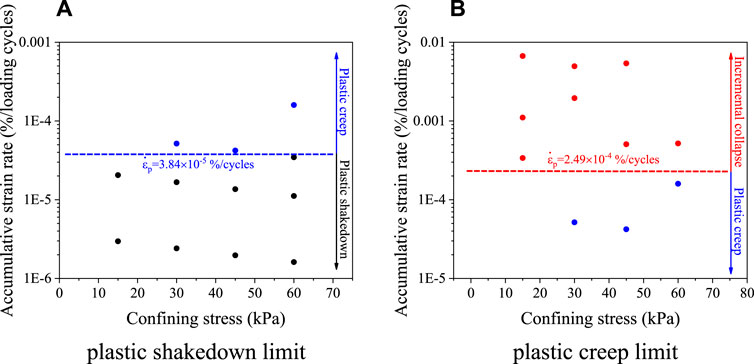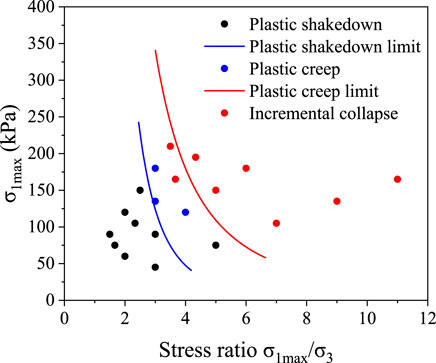Investigation on shakedown response-behavior of thawed subgrade soils under long-term traffic loading
- 1Shandong High-speed Construction Management Group Co., Ltd., Jinan, China
- 2School of Civil Engineering, Shandong University, Jinan, China
- 3School of Civil Engineering, Chongqing University, Chongqing, China
The shakedown state of the subgrade is crucial for the sustainable design and long-term stability evaluation of pavement structures. In order to characterize the plastic deformation and shakedown behavior of subgrade soil in seasonal frozen regions, cyclic triaxial tests were conducted on the thawed subgrade soil after seven cycles of freeze-thaw. The influences of the numbers of cycle loading, the amplitude of cyclic deviator stress, and the confining stress were considered variables. The evolution features of accumulative plastic strain, accumulative plastic strain rate, and critical dynamic stress were experimentally analyzed. Based on the shakedown theory, the ensuing discoveries were that the accumulative plastic strain response-behavior of thawed subgrade soil was typically divided into plastic shakedown, plastic creep, and incremental collapse under the long-term cyclic loading. Furthermore, the shakedown standard for thawed subgrade soil was also proposed based on the evolution of the accumulative plastic strain rate. The critical dynamic stresses can be obtained by the proposal formula to determine the different plastic deformation ranges.
1 Introduction
The subgrade is regarded as the support layer for the pavement or railway structures and undertakes the dynamic stress induced by the moving traffic loadings (Beskou and Theodorakopoulos, 2011; Krechowiecki-Shaw et al., 2016; Bian et al., 2018; Cui et al., 2022; Cui et al., 2023a; Cui et al., 2023b; Cui et al., 2024). Under long-term cyclic loadings, the accumulative plastic deformation of subgrade soils gradually increases, where the accumulative plastic deformation induced by long-term traffic loading accounts for the majority (75%–90%) of the total permanent deformation of the subgrade (Li and Selig, 1996; Chai and Miura, 2002; Puppala et al., 2009; Cui et al., 2014; Cai et al., 2018; Lu et al., 2018; Zhang et al., 2020a; Zhao et al., 2024). The overlarge permanent deformation in the subgrade layer will lead to pavement failures, such as uneven settlement, rutting, or cracking disasters in the asphalt layer (Brown, 1996). It is worth noting that when the pavement infrastructures are constructed in the seasonal frozen regions, the development trends of permanent deformation of subgrade soils will accelerate dramatically subject to the coupled effect of cyclic loading and freeze-thaw cycle (Lin et al., 2017; Wang et al., 2018; Lu et al., 2019; Hao et al., 2022; Hao et al., 2023; Pei et al., 2024). Meanwhile, the shakedown behavior of subgrade soils can be considered a reliable evaluation of the long-term performance of subgrade structures in the service period (Werkmeister et al., 2011). Thus, the credible understanding of accumulative plastic strain and the shakedown response of thawed subgrade soil can be considered an urgent demand for pavement and subgrade engineering in seasonal frozen regions.
The permanent deformation under traffic loading and critical dynamic stress are the essential parameters for pavement structure designs and performance maintenance that meet the allowable deformation limit based on the shakedown theory. The shakedown theory was first applied to reveal the dynamic behavior-response of the ideal elastic-plastic materials subjected to cyclic loadings. In the field of pavement engineering, the shakedown theory was introduced into the design of pavement structure and assessment of in-service life by Sharp and Booker (1984) and has been used widely to explore the plastic permanent deformation behavior of pavement materials (Boulbibane et al., 2005; Chazallon et al., 2009; Xiao et al., 2017; Qian et al., 2019; Wang and Yu, 2021; Liu et al., 2022; Lei et al., 2023). Then, S. Werkmeister et al. (Werkmeister et al., 2011) developed the primary concept of shakedown theory for application in subgrade engineering, which illustrated that the plastic deformation characteristics of subgrade materials can be classified into three types based on the shakedown theory (Figure 1).
1. Plastic shakedown (range A) means that when the cyclic load level is low, the granular material first appears as small plastic deformation, and then the overall deformation behavior changes to resilient deformation with the increase of loading cycles. This deformation type indicates that the plastic permanent deformation behavior of the subgrade structure is safe, which is considered the ideal state of the subgrade material in the design.
2. Plastic creep (range B) means that when the cyclic load level is higher, the granular material first appears as a certain plastic deformation, and then with the increase in loading cycles, the plastic deformation gradually increases but the accumulative deformation rate basically remains stable. This deformation type indicates that the permanent deformation behavior of the subgrade structure is controllable and safe within a certain service life, which is considered the controllable allowable state of the subgrade material in the design.
3. Incremental collapse (range C) means that when the cyclic load level is high, the development of plastic deformation of granular materials increases sharply with the increase in loading cycles, and the accumulative deformation rate keeps increasing, which finally leads to structure failure due to the excessive permanent deformation. This deformation type indicates that the permanent deformation behavior of the subgrade structure is uncontrollable and unsafe, and this state should be avoided for the subgrade materials in the design.
For the subgrade materials, many researchers proposed different standards to judge the permanent deformation behaviors and calculated the different deformation areas boundaries and critical dynamic stress, such as for unbound granular material (Gu et al., 2017; Xiao et al., 2018a; Xiao et al., 2018b; Zhao et al., 2022), coarse-grained soil (Leng et al., 2017; Zhai et al., 2020; Wang and Zhuang, 2021), fine-grained soil (Zhang et al., 2020b; Li et al., 2021; Cui et al., 2023c), and frozen soil (Wang et al., 2018; Zhou et al., 2020; Zhou et al., 2022). For the highway engineering practice, the sustainable design and hazard prevention of pavement structures demand an in-depth understanding of the plastic deformation and shakedown behavior of the thawed subgrade soils to further meet the requirement of long-term serviceability. However, according to the above literature review, there is a lack of comprehensive understanding for analyzing the shakedown response-behavior of thawed subgrade soils.
Thus, this paper aims to experimentally reveal the evolution of the accumulative plastic strain behavior of thawed subgrade soils by freeze-thaw and cyclic triaxial tests conducted on the subgrade soils. Furthermore, the classification standards for different limits of plastic deformation ranges and calculations for critical dynamic stress are established based on the shakedown theory.
2 Experimental investigation
2.1 Tested soil and specimen
The subgrade soils used for plastic deformation tests were selected from the low liquid silt (ML) that had a strong freeze-thaw sensitivity and poor water stability, whereas these typical silt soils have been widely constructed in seasonally frozen subgrade engineering (Xiao et al., 2014; Zhang et al., 2020b; Li et al., 2021; Hao et al., 2022; Cui et al., 2023a; Hao et al., 2023; Zhang et al., 2023). Meanwhile, the silt soils in this paper were taken from the highway construction site of the Rizhao-Lankao highway in Shandong Province, China (Hao et al., 2023). The gradation curve and basic physical properties are presented in Figure 2 and Table 1. Besides, the cylinder specimens were prepared and remodeled with a diameter of 39.1 mm and height of 80 mm, where the compaction degree and initial moisture content were set as 96% and optimal moisture content, respectively.
2.2 Test procedure
2.2.1 Freeze-thaw setting
According to existing literature, the mechanical properties of fine-grained soils would be a stable state after 7–10 times of freeze-thaw cycles in the seasonal frozen environment (Qi et al., 2006; Qi et al., 2008; Wang et al., 2015; Liu et al., 2016; Lin et al., 2017; Zhang et al., 2021), and combining the previous studies of silt by our group, the tested subgrade soils were chosen as thawed silt subjected to the 7 times of freeze-thaw cycles (Hao et al., 2022; Hao et al., 2023; Zhang et al., 2023). Moreover, the freezing temperature and thawing temperature were set as −10°C and 15°C, respectively.
2.2.2 Cyclic loading setting
The cyclic loading mode takes the single-stage loading used by the triaxial repeated loading device, and the half-sine wave was adopted to simulate the dynamic stress of subgrade soil induced by traffic loading (Ramos et al., 2020). The stress levels were set as 30, 60, 90, 120, and 150 kPa for amplitude of cyclic deviator stress and 15, 30, 45, and 60 kPa for confining stress, which is considered the stress state of subgrade under traffic loading and the further development of load level of heavy-haul traffic loading, and the determination of stress levels were based on the subgrade dynamic response of the theoretical model and in situ test by our research group (Cui et al., 2022; Cui et al., 2023a; Cui et al., 2023b). The loading progress is divided into the consolidation stage and cyclic loading stage, where the consolidation stress is equal to the confining stress of the soil specimen, and the number of loading cycles is 10000, as shown in Table 2 and Figure 3, where the loading frequency is set as 1 Hz considering the moving speed of highway (Cui et al., 2023a). Meanwhile, due to freeze-thaw cycles occurring mostly on the surface of the subgrade and the persistence and instantaneity of traffic loads, the fine-grained soil subgrade generally has no time for drainage during the melting stage. Therefore, the cyclic triaxial test in this manuscript is selected as the undrained test. Besides, the failure standard of the soil specimen was taken as 10% axial strain that stops loading, or else the loading stage continues to the 10000 numbers of loading cycles.
3 Results and discussions
3.1 Analysis of plastic deformation behavior
Figure 4 shows the development of an accumulative plastic strain of thawed silts under different stress states. It can be concluded obviously that the accumulative plastic strain increases with the increase of deviator stress amplitude. Taking Figure 4B as an example, it can be known that when the amplitude of cyclic deviator stress is smaller (σd = 30 and 60 kPa), the accumulative plastic strain of soil specimens increases rapidly only at the initial stage of the cyclic loading, then the development of accumulative plastic strain remains in a stable state, where the value of accumulative plastic strain is 0.23% and 1.58% at the 10000 numbers of loading cycles, corresponding to σd = 30 and 60 kPa, respectively. With the increase of amplitude of cyclic deviator stress to 90 kPa, the development of accumulative plastic strain not only increases rapidly at the initial stage of cyclic loading but also maintains a certain increased trend at the subsequent loading stage. Although the soil specimen remains in a stable state at the end of the loading (N = 10000), the accumulative plastic strain and accumulative strain rate of the soil specimen are large at this state. If the soil specimen continues to be cyclically loaded, the specimen may fail due to excessive accumulative plastic strain. Thereafter, when the amplitude of cyclic deviator stress is further increased to 120 and 150 kPa, the accumulative plastic strain increases dramatically until it reaches the experimental termination standard at the initial stage of the cyclic loading.
Furthermore, Figure 4 shows that with the increase in confining pressure, the accumulative plastic strain of soil specimen decreases obviously under the same amplitude of cyclic deviator stress. When the confining stress is at a high level, the accumulative plastic strain increases sharply at the initial stage of cyclic loading, and with the increase in the number of loading cycles, the accumulative plastic strain gradually slows down and remains in a stable state. However, when the confining stress is at a low level, the accumulative plastic strain under the same amplitude of cyclic deviator stress does not tend to be stable at the subsequent loading stage but still increases at a certain accumulative deformation rate, and the soil structures present eventually become incremental plastic failure. The reason is that the radial constraints on the soil skeleton are produced by increasing confining stress, which means that a more compact soil skeleton structure can resist greater cyclic load manifested as a process of accumulative plastic strain reduction from a macro perspective.
3.2 Shakedown standard for typical deformation range
In order to determine the deformation range that belongs to which dynamic state of thawed subgrade soil, it is indispensable to propose a classification standard for different accumulative plastic strain behaviors of thawed soils under long-term cyclic loading. Based on the shakedown theory, S. Werkmeister et al. (Werkmeister et al., 2011) proposed two methods for analyzing the plastic deformation behavior of subgrade soils. One method is that the difference of accumulative plastic strain corresponding to fixed loading times (3,000 and 5,000) is used as the standard of plastic deformation behavior. The other method is the relationship between the accumulative plastic strain and the accumulative strain rate. S. Werkmeister et al. (Werkmeister et al., 2011) observed that there were significant differences in the variation rules of accumulative plastic strain rate corresponding to different types of deformation behaviors as shown in Figure 5, and the accumulative plastic strain rate changes under different types of plastic deformation properties were statistically analyzed to establish a classification criterion based on the accumulative plastic strain rate for three plastic deformation behaviors of coarse-grained soil. However, the first method was not suitable for thawed subgrade silt under long-term traffic loading because, for the incremental collapse specimen, the loading numbers were approximately 3,000 times lower, corresponding to the failure state. Thus, the second method was selected for this paper. Meanwhile, the accumulative plastic strain rate is defined and calculated as Eq. 1.
Then, by using this method mentioned above, Li et al. (2021) and Wang et al. (Wang and Zhuang, 2021) were the proposed shakedown standard for silty soil and coarse-grained soil under cyclic loading, respectively. Thus, this paper established a shakedown standard for thawed subgrade soils by analyzing the accumulative plastic strain rate.
where
Figure 6 shows the accumulative plastic strain rates of thawed subgrade soils by processing the experimental data. It can be concluded clearly that the accumulative plastic strain rates of thawed subgrade soils can be classified into three categories: first, with the increase in loading cycles, the accumulative plastic strain rate of the specimen continues to decrease to a lower level, and the accumulative plastic strain is basically stable, which is determined to be plastic shakedown state, namely, range A; second, although the accumulative plastic strain rate decreases with the increase in loading cycles, it still maintains a certain level, and the accumulative plastic strain is still in a continuous development state, which is determined to be plastic creep state, namely, range B; third, the accumulative plastic strain rate decreases with the increase in loading cycles, but it still remains at a high level, and the accumulative plastic strain still increases rapidly, which is determined to be incremental collapse state, namely, range C. According to the above analysis, the classification results of thawed subgrade soils under various stress states have been noted in Figure 6.
The distributions of accumulative plastic strain rates of different plastic deformation behaviors are plotted, using counting minimum values of accumulative plastic strain rates of different ranges, as shown in Figure 7. Then, it can be indicated that the accumulative plastic strain rates under different plastic deformation behaviors show obvious differences and limits. The limit between plastic shakedown and plastic creep is defined as the plastic shakedown limit. The limit between plastic creep and incremental collapse is defined as the plastic creep limit. Furthermore, the intermediate values of the upper and lower boundary values are used as the critical rates for different plastic deformation behaviors, and the results are calculated by Eqs 2–4, which is the shakedown standard for determining the plastic deformation behavior of the thawed subgrade soils.
Plastic shakedown range:
Plastic creep range:
Incremental collapse range:
3.3 Critical dynamic stress formula
In the shakedown theory, the critical dynamic stress for plastic shakedown and plastic creep limits can be expressed by the following equation (Werkmeister et al., 2011):
where the σ1max is the maximum of axial stress, σ3 is the confining stress, α and β are the material parameters.
According to the above method, it can be seen from Figure 8 that the different plastic deformations have obvious boundaries, and the plastic shakedown, plastic creep, and incremental collapse are located in the left, middle, and right regions, respectively. Based on the distribution as shown in Figure 8, the calculation formulas can be fitted by Eq. 5. The fitted results and the calculations for critical dynamic stress are obtained and listed as Eqs 6 and 7 for plastic shakedown limit and plastic creep limit, respectively. It should be noted that due to the limited experimental conditions and data in this paper, the empirical formula for the critical dynamic stress still needs more experimental data for improvement.
Plastic shakedown limit:
Plastic creep limit:
4 Conclusion
In this paper, a series of cyclic triaxial tests were conducted on the thawed subgrade soil to explore the accumulative plastic strain behavior under long-term traffic loading where the low liquid silt was selected as the typical subgrade material. The shakedown theory was adopted to analyze the evolution of the accumulative plastic deformation of the thawed subgrade soil, the shakedown standards for classifying different deformation ranges were investigated, and the calculations for critical dynamic stress were proposed based on the experimental results. The conclusions are summarized as follows:
(1) The development of an accumulative plastic strain of thawed subgrade soils was classified into three categories: plastic shakedown, plastic creep, and incremental collapse under different stress states. The dominant influences on the plastic deformation were caused by the amplitude of cyclic deviator and confining stress levels.
(2) By using the concept of accumulative plastic strain rate, the plastic deformation ranges were analyzed in detail, and the criteria of range classification were also defined, that is, the accumulative rate was greater than 2.49×10−4%/cycles for incremental collapse range, less than 3.84×10−5%/cycles for plastic shakedown range, and the other range for plastic creep state.
(3) The boundary functions for three different ranges were established through the confining stress (σ3) and axial stress maximum (σ1max), which is defined as the calculations for critical dynamic stress of plastic shakedown limit and plastic creep limit. This can provide a theoretical guideline for the evaluation of subgrade stability in the design and dynamic control in the service period.
Data availability statement
The original contributions presented in the study are included in the article/Supplementary material, further inquiries can be directed to the corresponding authors.
Author contributions
SW: Investigation, Writing–original draft. XL: Formal Analysis, Methodology, Writing–original draft. YT: Conceptualization, Writing–original draft. XZ: Writing–original draft. TY: Writing–original draft. RW: Writing–review and editing. XJ: Writing–review and editing. ZS: Writing–original draft. JH: Supervision, Validation, Writing–original draft, Writing–review and editing.
Funding
The author(s) declare that no financial support was received for the research, authorship, and/or publication of this article.
Conflict of interest
Authors SW, YT, TY, RW, XJ, and ZS were employed by Shandong High-speed Construction Management Group Co., Ltd.
The remaining authors declare that the research was conducted in the absence of any commercial or financial relationships that could be construed as a potential conflict of interest.
Publisher’s note
All claims expressed in this article are solely those of the authors and do not necessarily represent those of their affiliated organizations, or those of the publisher, the editors and the reviewers. Any product that may be evaluated in this article, or claim that may be made by its manufacturer, is not guaranteed or endorsed by the publisher.
References
Beskou, N. D., and Theodorakopoulos, D. D. (2011). Dynamic effects of moving loads on road pavements: a review. Soil Dyn. Earthq. Eng. 31 (4), 547–567. doi:10.1016/j.soildyn.2010.11.002
Bian, X., Li, W., Hu, J., Liu, H., Duan, X., and Chen, Y. (2018). Geodynamics of high-speed railway. Transp. Geotech. 17, 69–76. doi:10.1016/j.trgeo.2018.09.007
Boulbibane, M., Collins, I. F., Ponter, A. R. S., and Weichert, D. (2005). Shakedown of unbound pavements. Road Mater. Pavement Des. 6 (1), 81–96. doi:10.1080/14680629.2005.9690000
Brown, S. F. (1996). Soil mechanics in pavement engineering. Geotechnique 46 (3), 383–426. doi:10.1680/geot.1996.46.3.383
Cai, Y., Chen, Y., Cao, Z., and Ren, C. (2018). A combined method to predict the long-term settlements of roads on soft soil under cyclic traffic loadings. Acta Geotech. 13 (5), 1215–1226. doi:10.1007/s11440-017-0616-3
Chai, J. C., and Miura, N. (2002). Traffic-load-induced permanent deformation of road on soft subsoil. J. Geotechnical Geoenvironmental Eng. 128 (11), 907–916. doi:10.1061/(asce)1090-0241(2002)128:11(907)
Chazallon, C., Koval, G., Hornych, P., Allou, F., and Mouhoubi, S. (2009). Modelling of rutting of two flexible pavements with the shakedown theory and the finite element method. Comput. Geotechnics 36 (5), 798–809. doi:10.1016/j.compgeo.2009.01.007
Cui, K., Qing, Y., Li, Q., Zhang, D., Li, P., and Liu, J. (2023c). Plastic shakedown limit of compacted clay: experiments and predicted model. Eng. Geol. 320, 107057. doi:10.1016/j.enggeo.2023.107057
Cui, X., Du, Y., Bao, Z., Xiao, Y., Hao, J., Li, X., et al. (2023b). Field evaluation of the three-dimensional dynamic stress state of the subgrade induced by the heavy-haul train load. Transp. Geotech. 38, 100903. doi:10.1016/j.trgeo.2022.100903
Cui, X., Du, Y., Hao, J., Bao, Z., Jin, Q., Li, X., et al. (2023a). Three-dimensional spatial stress state of highway subgrade under vehicle load: experimental evidence and evaluation model. Int. J. Pavement Eng. 24 (1). doi:10.1080/10298436.2023.2268795
Cui, X., Li, X., Du, Y., Bao, Z., Zhang, X., Hao, J., et al. (2024). Macro-micro numerical analysis of granular materials considering principal stress rotation based on DEM simulation of dynamic hollow cylinder test. Constr. Build. Mater. 412, 134818. doi:10.1016/j.conbuildmat.2023.134818
Cui, X., Li, X., Hao, J., Wang, Y., Bao, Z., Du, Y., et al. (2022). Dynamic response of unsaturated poroelastic ground underlying uneven pavement subjected to vehicle load. Soil Dyn. Earthq. Eng. 156, 107164. doi:10.1016/j.soildyn.2022.107164
Cui, X., Zhang, N., Zhang, J., and Gao, Z. (2014). In situ tests simulating traffic-load-induced settlement of alluvial silt subsoil. Soil Dyn. Earthq. Eng. 58, 10–20. doi:10.1016/j.soildyn.2013.11.010
Gu, F., Zhang, Y., Luo, X., Sahin, H., and Lytton, R. L. (2017). Characterization and prediction of permanent deformation properties of unbound granular materials for Pavement ME Design. Constr. Build. Mater. 155, 584–592. doi:10.1016/j.conbuildmat.2017.08.116
Hao, J., Cui, X., Bao, Z., Jin, Q., Li, X., Du, Y., et al. (2023). Dynamic resilient modulus of heavy-haul subgrade silt subjected to freeze-thaw cycles: experimental investigation and evolution analysis. Soil Dyn. Earthq. Eng. 173, 108092. doi:10.1016/j.soildyn.2023.108092
Hao, J., Cui, X., Qi, H., Zheng, Y., and Bao, Z. (2022). Dynamic behavior of thawed saturated saline silt subjected to freeze-thaw cycles. Cold Regions Sci. Technol. 194, 103464. doi:10.1016/j.coldregions.2021.103464
Krechowiecki-Shaw, C. J., Jefferson, I., Royal, A., Ghataora, G. S., and Alobaidi, I. M. (2016). Degradation of soft subgrade soil from slow, large, cyclic heavy-haul road loads: a review. Can. Geotechnical J. 53 (9), 1435–1449. doi:10.1139/cgj-2015-0234
Lei, H., Zhang, J.-F., Qian, J.-G., Dai, Y.-C., and Shen, J. (2023). Dynamic shakedown limits of the pavement on saturated subgrade subjected to traffic rolling-sliding loading. Comput. Geotechnics 163, 105743. doi:10.1016/j.compgeo.2023.105743
Leng, W., Xiao, Y., Nie, R., Zhou, W., and Liu, W. (2017). Investigating strength and deformation characteristics of heavy-haul railway embankment materials using large-scale undrained cyclic triaxial tests. Int. J. Geomechanics 17 (9). doi:10.1061/(asce)gm.1943-5622.0000956
Li, D., and Selig, E. T. (1996). Cumulative plastic deformation for fine-grained subgrade soils. J. Geotechnical Eng. 122 (12), 1006–1013. doi:10.1061/(asce)0733-9410(1996)122:12(1006)
Li, Y., Nie, R., Leng, W., Guo, Y., Dong, J., and Sun, B. (2021). Cumulative permanent strain and critical dynamic stress of silty filler for subgrade subjected to intermittent cyclic loading of trains. Bull. Eng. Geol. Environ. 80 (4), 3079–3096. doi:10.1007/s10064-021-02125-5
Lin, B., Zhang, F., Feng, D., Tang, K., and Feng, X. (2017). Accumulative plastic strain of thawed saturated clay under long-term cyclic loading. Eng. Geol. 231, 230–237. doi:10.1016/j.enggeo.2017.09.028
Liu, H., Wang, C., Liu, X., Wu, D., Yang, H., Zhang, Z., et al. (2022). Deformation characteristics and prediction of unbound volcanic ash pavement based on the mechanistic-empirical design guide. Constr. Build. Mater. 327, 126975. doi:10.1016/j.conbuildmat.2022.126975
Liu, J., Chang, D., and Yu, Q. (2016). Influence of freeze-thaw cycles on mechanical properties of a silty sand. Eng. Geol. 210, 23–32. doi:10.1016/j.enggeo.2016.05.019
Lu, Z., Fang, R., Yao, H., Hu, Z., and Liu, J. (2018). Evaluation and analysis of the traffic load–induced settlement of roads on soft subsoils with low embankments. Int. J. Geomechanics 18 (6). doi:10.1061/(asce)gm.1943-5622.0001123
Lu, Z., She, J., Wu, X., and Yao, H. (2019). Cumulative strain characteristics of compacted soil under effect of freeze-thaw cycles with water supply. Transp. Geotech. 21, 100291. doi:10.1016/j.trgeo.2019.100291
Pei, Q. Y., Zou, W. L., Han, Z., Wang, X. Q., and Xia, X. L. (2024). Compression behaviors of a freeze–thaw impacted clay under saturated and unsaturated conditions. Acta Geotech. doi:10.1007/s11440-023-02188-6
Puppala, A. J., Saride, S., and Chomtid, S. (2009). Experimental and modeling studies of permanent strains of subgrade soils. J. Geotechnical Geoenvironmental Eng. 135 (10), 1379–1389. doi:10.1061/(asce)gt.1943-5606.0000163
Qi, J., Ma, W., and Song, C. (2008). Influence of freeze–thaw on engineering properties of a silty soil. Cold Regions Sci. Technol. 53 (3), 397–404. doi:10.1016/j.coldregions.2007.05.010
Qi, J., Vermeer, P. A., and Cheng, G. (2006). A review of the influence of freeze-thaw cycles on soil geotechnical properties. Permafr. Periglac. Process. 17 (3), 245–252. doi:10.1002/ppp.559
Qian, J., Wang, Y., Wang, J., and Huang, M. (2019). The influence of traffic moving speed on shakedown limits of flexible pavements. Int. J. Pavement Eng. 20 (2), 233–244. doi:10.1080/10298436.2017.1293259
Ramos, A., Gomes Correia, A., Indraratna, B., Ngo, T., Calçada, R., and Costa, P. A. (2020). Mechanistic-empirical permanent deformation models: laboratory testing, modelling and ranking. Transp. Geotech. 23, 100326. doi:10.1016/j.trgeo.2020.100326
Sharp, R. W., and Booker, J. R. (1984). Shakedown of pavements under moving surface loads. J. Transp. Eng. 110 (1), 1–14. doi:10.1061/(asce)0733-947x(1984)110:1(1)
Wang, J., Ling, X., Li, Q., Zhang, F., and Li, Y. (2018). Accumulated permanent strain and critical dynamic stress of frozen silty clay under cyclic loading. Cold Regions Sci. Technol. 153, 130–143. doi:10.1016/j.coldregions.2018.05.007
Wang, J., and Yu, H. S. (2021). Shakedown analysis and its application in pavement and railway engineering. Comput. Geotechnics 138, 104281. doi:10.1016/j.compgeo.2021.104281
Wang, K., and Zhuang, Y. (2021). Characterizing the permanent deformation Response-Behavior of subgrade material under cyclic loading based on the shakedown theory. Constr. Build. Mater. 311, 125325. doi:10.1016/j.conbuildmat.2021.125325
Wang, T.-l., Liu, Y.-j., Yan, H., and Xu, L. (2015). An experimental study on the mechanical properties of silty soils under repeated freeze–thaw cycles. Cold Regions Sci. Technol. 112, 51–65. doi:10.1016/j.coldregions.2015.01.004
Werkmeister, S., Dawson, A. R., and Wellner, F. (2011). Permanent deformation behaviour of granular materials. Road Mater. Pavement Des. 6 (1), 31–51. doi:10.3166/rmpd.6.31-51
Xiao, J., Juang, C. H., Xu, C., Li, X., and Wang, L. (2014). Strength and deformation characteristics of compacted silt from the lower reaches of the Yellow River of China under monotonic and repeated loading. Eng. Geol. 178, 49–57. doi:10.1016/j.enggeo.2014.06.008
Xiao, J., Zhang, D., Wei, K., and Luo, Z. (2017). Shakedown behaviors of railway ballast under cyclic loading. Constr. Build. Mater. 155, 1206–1214. doi:10.1016/j.conbuildmat.2017.07.225
Xiao, Y., Zhang, Z., Chen, L., and Zheng, K. (2018a). Modeling stress path dependency of cyclic plastic strain accumulation of unbound granular materials under moving wheel loads. Mater. Des. 137, 9–21. doi:10.1016/j.matdes.2017.10.024
Xiao, Y., Zheng, K., Chen, L., and Mao, J. (2018b). Shakedown analysis of cyclic plastic deformation characteristics of unbound granular materials under moving wheel loads. Constr. Build. Mater. 167, 457–472. doi:10.1016/j.conbuildmat.2018.02.064
Zhai, B., Leng, W., Xu, F., Zhang, S., Ye, X., and Leng, H. (2020). Critical dynamic stress and shakedown limit criterion of coarse-grained subgrade soil. Transp. Geotech. 23, 100354. doi:10.1016/j.trgeo.2020.100354
Zhang, J., Peng, J., Zhang, A., and Li, J. (2020a). Prediction of permanent deformation for subgrade soils under traffic loading in Southern China. Int. J. Pavement Eng. 23, 673–682. doi:10.1080/10298436.2020.1765244
Zhang, L., Ren, F., Li, H., Cheng, D., and Sun, B. (2021). The influence mechanism of freeze-thaw on soil erosion: a review. Water 13 (8), 1010. doi:10.3390/w13081010
Zhang, X., Zhang, Y., Liu, X., Liu, J., and Liu, J. (2020b). Shakedown behavior of yellow river alluvial silt stabilized with lignin–lime combined additive. J. Mater. Civ. Eng. 32 (1). doi:10.1061/(asce)mt.1943-5533.0002954
Zhang, X.-n., Cui, X.-z., Ding, L.-q., Luan, J.-y., Wang, Y.-l., Jiang, P., et al. (2023). Effects of a novel hybrid polymer material on the hydro-mechanical behavior of subgrade silts considering freeze-thaw cycles. Cold Regions Sci. Technol. 205, 103698. doi:10.1016/j.coldregions.2022.103698
Zhao, J. S., Duan, S. Q., Chen, B. R., Li, L., He, B. G., Li, P. X., et al. (2024). Failure mechanism of rock masses with complex geological conditions in a large underground cavern: a case study. Soil Dyn. Earthq. Eng. 177, 108439. doi:10.1016/j.soildyn.2023.108439
Zhao, J. S., Jiang, Q., Lu, J. F., Chen, B. R., Pei, S. F., and Wang, Z. L. (2022). Rock fracturing observation based on microseismic monitoring and borehole imaging: in situ investigation in a large underground cavern under high geostress. Tunn. Undergr. Space Technol. 126, 104549. doi:10.1016/j.tust.2022.104549
Zhou, Z., Ma, W., Li, G., and Shen, M. (2020). A novel evaluation method for accumulative plastic deformation of granular materials subjected to cyclic loading: taking frozen subgrade soil as an example. Cold Regions Sci. Technol. 179, 103152. doi:10.1016/j.coldregions.2020.103152
Keywords: shakedown theory, accumulative plastic strain, subgrade soil, freeze-thaw cycles, critical dynamic stress
Citation: Wang S, Li X, Ti Y, Zhang X, Yin T, Wang R, Jiang X, Su Z and Hao J (2024) Investigation on shakedown response-behavior of thawed subgrade soils under long-term traffic loading. Front. Earth Sci. 12:1361283. doi: 10.3389/feart.2024.1361283
Received: 25 December 2023; Accepted: 05 February 2024;
Published: 07 March 2024.
Edited by:
Jianyong Han, Shandong Jianzhu University, ChinaReviewed by:
Wentong Wang, Shandong University of Science and Technology, ChinaJunhui Peng, Changsha University of Science and Technology, China
Copyright © 2024 Wang, Li, Ti, Zhang, Yin, Wang, Jiang, Su and Hao. This is an open-access article distributed under the terms of the Creative Commons Attribution License (CC BY). The use, distribution or reproduction in other forums is permitted, provided the original author(s) and the copyright owner(s) are credited and that the original publication in this journal is cited, in accordance with accepted academic practice. No use, distribution or reproduction is permitted which does not comply with these terms.
*Correspondence: Xiangyang Li, 1134236098@qq.com; Jianwen Hao, hjwww1717@163.com
 Shujian Wang1
Shujian Wang1  Jianwen Hao
Jianwen Hao